Ijraset Journal For Research in Applied Science and Engineering Technology
- Home / Ijraset
- On This Page
- Abstract
- Introduction
- Conclusion
- References
- Copyright
MedEase+ - A Healthcare System
Authors: D Vamsi, Shaik Kaleema, Varikallu Priyanka, P Y Rajkamal Tutu
DOI Link: https://doi.org/10.22214/ijraset.2024.59230
Certificate: View Certificate
Abstract
India is a very populous nation, recently surpassing China and Russia. According to the World Health Organization data from 2019, India had approximately 1.45 doctors per 1,000 people. Due to this difference in ratio, the issues related to soft flow of hospital management are on inclining graph. Therefore, the introduction of project MedEase+ comes into light. The purpose of this project is to implement a proper healthcare management system integrating all the basic functionalities powered by an Artificial Intelligent chat bot that is capable of having a very organic conversation with the user and solving their queries using knowledge base. The knowledge base is a collection of real-time data that is pre-processed using bag of words to prepare it for additional processing. The data is collected in a JSON format where Natural Language Understanding (NLU) comes into picture. The chat bot has the ability to offer navigation links based on the user\'s requests. Moreover, it has the ability to suggest seeking medical advice or taking any necessary instant action. And it also offers diagnostics information in advance. Furthermore, this project provides a robust web application using Django framework to carry out the functionalities and services of both hospital administration and user engagement.
Introduction
I. INTRODUCTION
One of the most important economic sectors is the healthcare industry. A robust healthcare system lowers family stress, boosts life expectancy, and promotes national growth—all of which contribute to a robust economy. The suggested system focuses on combining all fundamental features into a single application and powers it with an AI chat bot to add new features like simple navigation, access to doctor availability data, diagnostic information, symptom analysis, suggestions for preventative or quick medication, and appointment scheduling, all within a single application using a chat bot. A chat bot that mimics human communication is a computer software known as artificial intelligence (AI). It is a piece of software that uses written language to interact with people. It is commonly integrated into websites or other online applications to provide low-cost, hassle-free customer care by responding to queries from customers without the need for human agents. Machine learning-based chat bots generate artificial intelligence (AI) chat bots that are highly capable of conversing with users in an organic way and responding to their questions. Chat bots utilize different training algorithms to answer questions as precisely as possible based on the data that is presented to them. Our suggested approach generates a chat bot that can have conversations and is integrated with a hospital's website to help users to solve their queries instantly. Chat bot acts as a very effective interface between the user and the program. Users can ask questions in any format that isn't predetermined. The chat bot gives the best answer it can to the question. It is possible because of Natural language understanding (NLU) which is based on intents, that are widely used in chat bots, virtual assistants, and other conversational AI systems. They capture the fundamental goal or intention behind a user's message or input, making it easier for the system to accurately interpret and produce a response. This chat bot gives users access to diagnostics, physician availability, hospital information, and other relevant data. They can explore more quickly and easily because they are taken to different pages based on their demands. In order to be ready, they can make appointments and pinpoint the issue by outlining the symptoms. This enables them to arrange a quick doctor's appointment and take any required safety measures. The framework used for website building is Django, the website has both admin and user pages. The admin is one who maintains the hospital data whereas the user is the one who can utilize all the functionalities provided by the hospital management. The user must register himself to unlock all the functionalities. After a successful registration, the user should login using his credentials, the credentials are authenticated or validated using the registered data which is stored in the backend database, If passed the user gets logged into his or her user account. Using his or her own account one can access the chat bot and can book appointments and can take any guidance regarding healthcare. Better health outcomes are promoted by the proactive participation, which also strengthens the patient-provider connection by fostering a sense of empowerment and trust. By utilizing cutting-edge technologies such as machine learning and natural language understanding (NLU), the chatbot is able to interpret and respond to natural language inputs with greater accuracy over time. This results in interactions that are more meaningful and contextually relevant, which enhances the user experience in healthcare delivery overall.
II. LITERATURE REVIEW
The authors [1][8] emphasizes the crucial role of the healthcare sector in maintaining economic stability and improving patient outcomes through technological advancements. They developed chatbots that utilize real-time data integration and NLP techniques to facilitate organic conversations, schedule appointments, diagnose symptoms, and offer proactive medical consultation recommendations.
Mr. K. Manivannan [3] presents a linear design for the user dialogue in the proposed system, transitioning from symptom extraction to diagnosis and doctor referrals based on the severity of the disease. The system, relying on Natural Language Processing (NLP), facilitates user submissions of health complaints and queries, prioritizing customer satisfaction and welfare by providing guidance and medical assistance remotely through chatbots integrated with Google API for text-to-voice conversion.
Dange Anas [4] proposed method involves developing a web application integrated with a chatbot to provide disease symptom information and streamline interactions with hospital websites. This AI-based healthcare chatbot system, utilizing NLP, aims to offer user-friendly and secure disease diagnosis and health maintenance functionalities, potentially improving the current healthcare system's efficiency and effectiveness.
The authors [2][7][9], aimed at enhancing healthcare provider performance through human-like interactions facilitated by AIML code within the Spring Tool Suite. This chatbot offers information on herbal remedies, utilizing pattern matching to respond to user queries effectively and striving to emulate human-like behavior for a seamless user experience.
Mamta Mittal's [5] project integrates advanced algorithms, including Long Short-Term Memory (LSTM) and Recurrent Neural Networks (RNN), to enhance the healthcare chatbot's capabilities. By leveraging these algorithms for natural language processing (NLP) and speech recognition, the chatbot facilitates user interactions in both text and speech formats, improving accessibility and usability.
The authors [6][10] aims to offer an alternative to conventional hospital visits by leveraging natural language processing and machine learning to develop a chatbot application. This application enables users to interact in a human-like manner, aiding in symptom identification, disease prediction, and treatment recommendation, thereby promoting regular health check-ups and proactive healthcare measures without the need for hospital visits.
Considering all the above literature analysis, relying only on paper scheduling restricts patients' flexibility and accessibility. Many patients these days prefer the ease of online booking systems since they enable them to make appointments whenever they want, day or night, from the comfort of their homes. This is because we live in a digital age. Hospitals run the danger of alienating people and falling behind in fulfilling the changing expectations of patients for healthcare services if they do not offer substitute booking options like phone or online platforms. Thus, building a robust and user friendly chatbot is the major part of this project. Research on studies or initiatives that combine chatbots with healthcare apps to offer health monitoring, appointment booking, and medical consultation. This research helped us to look into how well chatbots work to improve patient outcomes or make healthcare more accessible. Natural Language Understanding is referred to as NLU. It's a subfield of computational linguistics and artificial intelligence (AI) that focuses on making it possible for computers to comprehend and interpret human language meaningfully. NLU uses a variety of methods and algorithms to understand and parse input, whether it be speech or text, extract pertinent details, and infer the intended meaning or context from it. NLU is used in a wide range of applications where the ability to interpret human language is necessary for communication or decision-making, such as chatbots, virtual assistants, sentiment analysis, language translation, and many more. NLU is also a subset of NLP which is shown in fig. 1, that has a focus on understanding human language. Deeper understanding of the context, intent, and meaning of the words and phrases used in communication is required. In order to determine the underlying semantics and pragmatics of language, NLU systems usually go beyond surface-level processing.
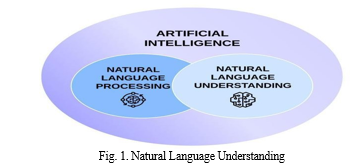
III. PROPOSED WORK
The aim of this project is to include all the basic functionalities of the hospital and basic needs of the patient into one application as shown in fig. 2. The chat bot which is embedded into the website carries all the essential tasks as a torch bearer of this system. This application helps the patient or users to access the information from any place instantly without human intervention that leads to soft work flow of the hospital management. The proposed application has the basic functionalities like
- Landing page of hospital management system: Which is the users first entry point to access all the information and services.
- Admin page: To lead the administration tasks of the hospital, the admin page allows access to various functionalities like doctors and user management, appointments management, feedback management, etc…
- User page: Hospital management provides specific services to the users where a user can access them using their user account.
- Chatbot: The bot's ability to interpret user inputs and customize relevant responses is based on its intents file, which is the foundation of its natural language understanding (NLU) skills. A chatbot's intents file is a fundamental part of its development and is essential to the smooth operation of communication between the bot and its users. It essentially serves as a database of pre-established user intentions, each of which captures the fundamental objectives or motives behind user inputs or communications. Through careful selection and arrangement of these intents within the file, the bot gains the ability to comprehend and react to a wide range of user requests and orders.
- Communication through emails: The special feature of this project is emails which acts as a communication bridge between the user and hospital management.

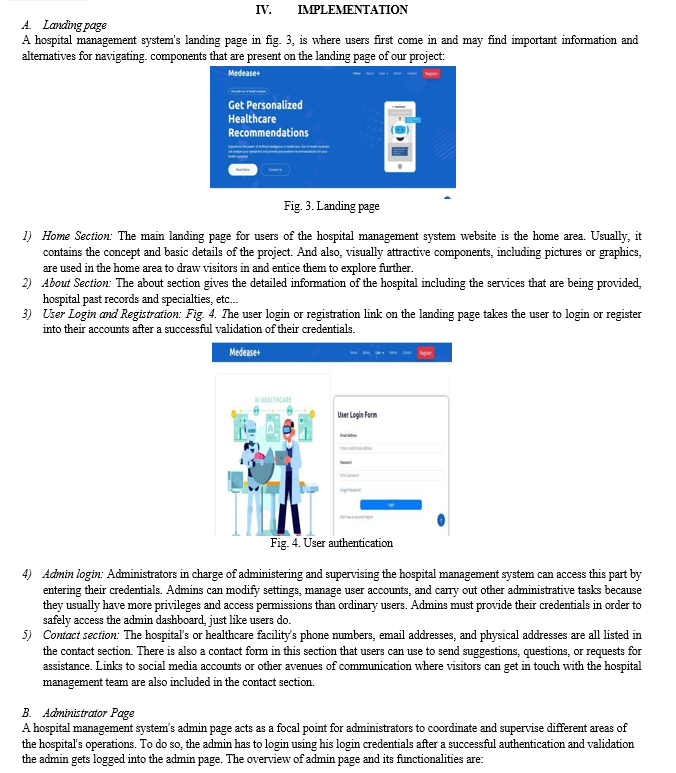
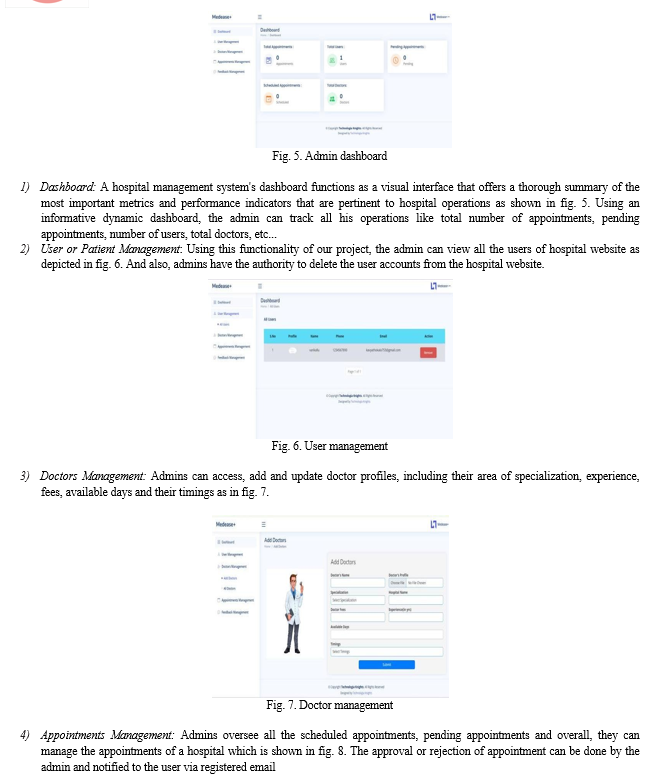

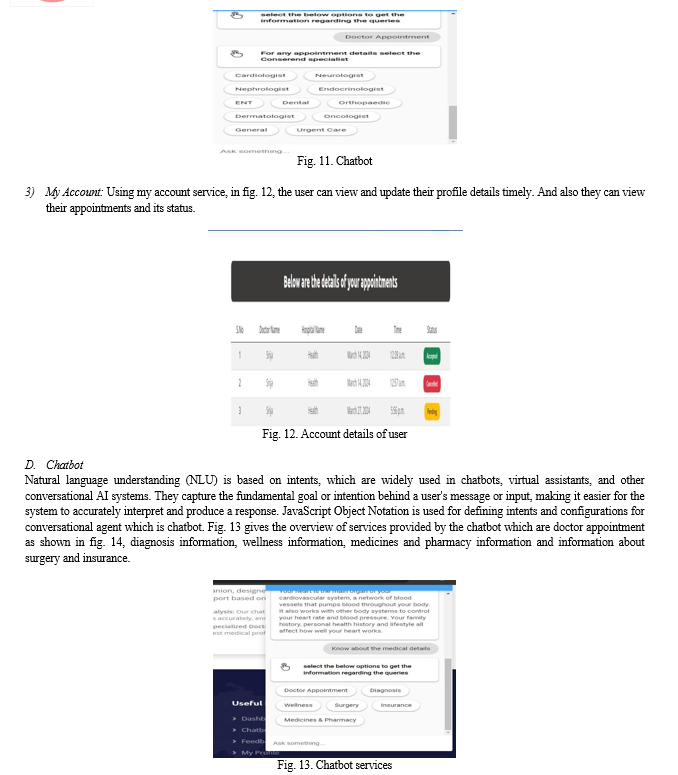
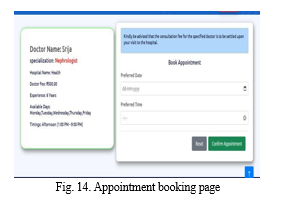
V. FUTURE SCOPE
The proposed project has enormous potential for growth and improvement in the future, opening the door for creative developments in healthcare technology. Among the possible possibilities for future expansion are:
- Improved Natural Language Understanding (NLU) skills: Constantly enhancing the chatbot's NLU skills to better understand user questions and provide contextually relevant and accurate responses. This entails combining deep learning models with cutting- edge machine learning algorithms to improve language comprehension and communication abilities.
- Multi-language Support: Adding multilingual support will help you reach a wider range of users and improve accessibility for non-native speakers. To provide seamless communication and engagement with users from diverse linguistic origins, this entails building multilingual natural language understanding (NLU) models and language processing capabilities.
- Personalized Health Recommendations: Utilizing data analytics and machine learning methods, customized health recommendations and treatments are produced based on each person's unique health profile, preferences, and behavioral patterns. This tailored strategy encourages proactive health management and improves the efficacy of healthcare interventions.
- Integration of various support mechanisms: The integration of toll-free number into the web application can also automate the process of appointment booking, queries about hospital, etc… which will be beneficial for the illiterate people to use the application independently.
Conclusion
With its user-friendly interface, the proposed project enables patients to easily connect with healthcare services, marking a significant development in healthcare technology. Patients now have access to a user-friendly and practical platform where they can easily book appointments, ask questions about their health, and seek medical advice by embedding a chatbot into the online application. By putting the needs of the patient first, this user-centric approach not only increases patient involvement but also frees up healthcare staff to concentrate more on providing high-quality treatment. Moreover, the incorporation of the chatbot within the online application contributes to improved patient satisfaction by offering timely, tailored, and easily accessible support. Patients may feel supported throughout their healthcare journey, receive prompt answers to their questions, and access pertinent healthcare information. The project not only improves healthcare accessibility but also sets a new standard for patient-centered care in the age of digital technology.
References
[1] Srinivasa Rao Dammavalam; N Chandana; T Rajeshwar Rao; A Lahari; B Aparna, “AI Based Chatbot for Hospital Management System”, 10.1109/ICAN56228.2022.10007105 [2] A Kumaresan Angappan, N Jazeem Khan, M Sharan and S Fazil Ahamed, “AI Based Healthcare Chatbot System”, 5260, March 31, 2021 [3] Mr. K.Manivannan, M.Tech.(Ph.D), G.Gokul, F.Johan, L.Aathiswaran, “CHATBOT FOR HOSPITAL MANAGEMENT USING ARTIFICIAL INTELLIGENCE TECHNOLOGY”, vol. 11, no. 2320-2882, 05-05-2021 [4] Dange Anas1 , Digole Suhas2 , Thakur Manthan3 , Mendapara Harsh4, AI Based Healthcare Chatbot System Using Natural Language Processing. [5] M. Mittal, B. Gopi, D. Singh, T. Nagarwal, P. Yadav, \"Web-based chatbot for frequently asked queries (FAQ) in hospitals\", Journal of Taibah University Medical Sciences, vol. 16, no. 5, pp. 740-746, 2021. [6] R. B. Mathew, S. Varghese, S. E. Joy and S. S. Alex, \"Chatbot for disease prediction and treatment recommendation using machine learning\", 3rd Int. Conference on Trends in Electronics and Informatics, pp. 851-856, 2019. [7] L. Athota, V. K. Shukla, N. Pandey and A. Rana, \"Chatbot for healthcare system using artificial intelligence\", 8th Int. Conference on Reliability, Infocom Technologies and Optimization, pp. 619-622, 2020. [8] D. S. Rao, K. L. Srikanth, J. Noshitha P. Pratyusha, M. Sucharitha, M. Tejaswini and T. Ashwini, \"Development of artificial intelligence based chatbot using deep neural network\", In: P. Raju and P. K. Shukla (eds), SCRS conference proceedings on intelligent systems, pp.143-151, 2021. [9] J. Weizenbaum, “ELIZA- A computer program for the study of natural language communication between man and machine”, CACM, vol. 9, no. 7, pp. 36-43, 1996. [10] N. Thakur, A. Hiwrale, S. Selote, A. Shinde and N. Mahakalkar, “Artificially intelligent chatbot”, Universal Research Reports, vol. 4 , no. 6, pp. 43-47, 2017.
Copyright
Copyright © 2024 D Vamsi, Shaik Kaleema, Varikallu Priyanka, P Y Rajkamal Tutu. This is an open access article distributed under the Creative Commons Attribution License, which permits unrestricted use, distribution, and reproduction in any medium, provided the original work is properly cited.

Download Paper
Paper Id : IJRASET59230
Publish Date : 2024-03-20
ISSN : 2321-9653
Publisher Name : IJRASET
DOI Link : Click Here
 Submit Paper Online
Submit Paper Online

